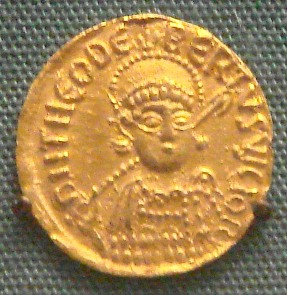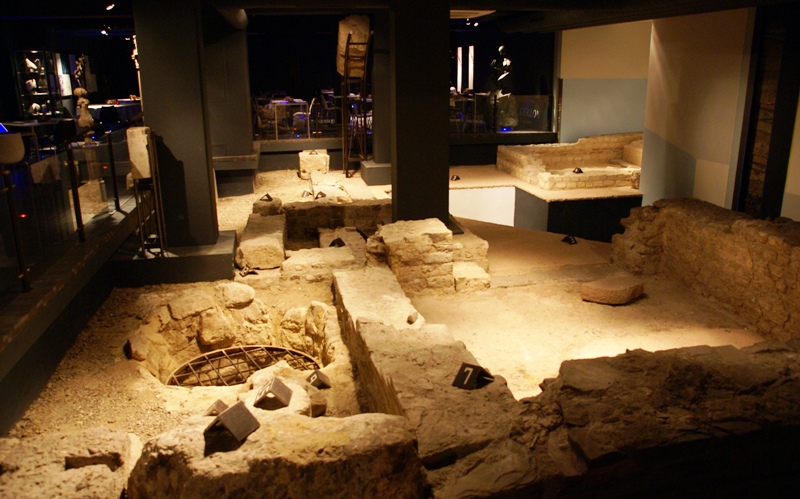|
Reginar I Longneck
Reginar Longneck or Reginar I ( 850–915), la, Rainerus or ''Ragenerus Longicollus'', was a leading nobleman in the kingdom of Lotharingia, variously described in contemporary sources with the titles of count, margrave, missus dominicus and duke. He stands at the head of a Lotharingian dynasty known to modern scholarship as the Reginarids, because of their frequent use of the name "Reginar". Background Reginar was probably the son of Gilbert, Count of the Maasgau, Giselbertus, ''comes'' of the Maasgau, and a daughter of Lothair I whose name is not known (Hiltrude, Bertha, Irmgard, and Gisela are candidate names). In an 877 charter in the Capitulary of Quierzy, he possibly already appears as "Rainerus", alongside his probable father as one of the regents of the kingdom during Charles the Bald's absence on campaign in Italy. Career Reginar was lay abbot of important abbeys stretching from the Meuse ( nl, Maas) to the Moselle through the Ardennes, Saint-Servais in Maastricht, Ech ... [...More Info...] [...Related Items...] OR: [Wikipedia] [Google] [Baidu] |
Duke Of Lorraine
The rulers of Lorraine have held different posts under different governments over different regions, since its creation as the kingdom of Lotharingia by the Treaty of Prüm, in 855. The first rulers of the newly established region were kings of the Franks. The Latin construction "Lotharingia" evolved over time into "Lorraine" in French, "Lotharingen" in Dutch and "Lothringen" in German. After the Carolingian kingdom was absorbed into its neighbouring realms in the late ninth century, dukes were appointed over the territory. In the mid-tenth century, the duchy was divided into Lower Lorraine and Upper Lorraine, the first evolving into the historical Low Countries, the second became known as the Duchy of Lorraine and existed well into the modern era. Kings of Lotharingia *Lothair II (855–869) Charles the Bald claimed Lotharingia on Lothair's death and was crowned king in Metz, but his brother Louis the German opposed his claim and in 870 the Treaty of Mersen divided Lotharingia b ... [...More Info...] [...Related Items...] OR: [Wikipedia] [Google] [Baidu] |
Lay Abbot
Lay abbot ( la, abbatocomes, abbas laicus, abbas miles, ) is a name used to designate a layman on whom a king or someone in authority bestowed an abbey as a reward for services rendered; he had charge of the estate belonging to it, and was entitled to part of the income. The custom existed principally in the Frankish Empire from the eighth century until the ecclesiastical reforms of the eleventh. Background Numerous synods held in France in the sixth and seventh centuries passed decrees against this abuse of church property. The Merovingians had bestowed church lands on laymen, or at least allowed them their possession and use, though not ownership.Kirsch, Johann Peter. "Lay Abbot." The Catholic Encyclopedia Vol. 9. New York: Robert Appleton Company, 1910. 26 Jul. 2015 The Merovingian kings were ... [...More Info...] [...Related Items...] OR: [Wikipedia] [Google] [Baidu] |
Alberic De Trois Fontaines
Alberic of Trois-Fontaines (french: Aubri or ''Aubry de Trois-Fontaines''; la, Albericus Trium Fontium) (died 1252) was a medieval Cistercian chronicler who wrote in Latin. He was a monk of Trois-Fontaines Abbey in the diocese of Châlons-sur-Marne. He died after 1252. He wrote a chronicle describing world events from the Creation to the year 1241. Life and works Alberic was likely from a noble Liège family which could afford a good education for him. He became a monk of Trois-Fontaines Abbey no later than 1230. In 1232 Alberic began his chronicle ''Chronica Albrici Monachi Trium Fontium'' and continued working on it at least until 1251 since he used a history by Gilles of Orval ''Gesta episcoporum Leodiensium'' ("Deeds of the Bishops of Liège"). His sources also included the universal chronicle of Sigebert of Gembloux and Books 45-49 of Helinand of Froidmont's ''Chronicon''. Alberic's chronicle describes world events from the Creation and contains original writing starting ... [...More Info...] [...Related Items...] OR: [Wikipedia] [Google] [Baidu] |
William Of Jumièges
William of Jumièges (born c. 1000 - died after 1070) (french: Guillaume de Jumièges) was a contemporary of the events of 1066, and one of the earliest writers on the subject of the Norman conquest of England. He is himself a shadowy figure, only known by his dedicatory letter to William the Conqueror as a monk of Jumièges. Since he also mentions that he was an eyewitness of some events from the reign of Duke Richard III (1026-7), it seems reasonable to assume that he was born some time about the year 1000. He probably entered the monastery during the first quarter of the eleventh century and received his education from Thierry de Mathonville. According to Orderic Vitalis, William's nickname was "Calculus". The meaning behind this nickname is unknown. His death, after 1070, is unrecorded. He was a Norman writing from a Norman point of view. Although only a monk with evidently no military training, he wrote with pride in the accomplishments of his people. William of Jumièges was ... [...More Info...] [...Related Items...] OR: [Wikipedia] [Google] [Baidu] |
Rollo Of Normandy
Rollo ( nrf, Rou, ''Rolloun''; non, Hrólfr; french: Rollon; died between 928 and 933) was a Viking who became the first ruler of Normandy, today a region in northern France. He emerged as the outstanding warrior among the Norsemen who had secured a permanent foothold on Frankish soil in the valley of the lower Seine. After the Siege of Chartres in 911, Charles the Simple, the king of West Francia, granted them lands between the mouth of the Seine and what is now Rouen in exchange for Rollo agreeing to end his brigandage, swearing allegiance to him, religious conversion and a pledge to defend the Seine's estuary from Viking raiders. The name Rollo is first recorded as the leader of these Viking settlers in a charter of 918, and he continued to reign over the region of Normandy until at least 928. He was succeeded by his son William Longsword in the Duchy of Normandy that he had founded. The offspring of Rollo and his followers, through their intermingling with the indigenous ... [...More Info...] [...Related Items...] OR: [Wikipedia] [Google] [Baidu] |
Frisians
The Frisians are a Germanic ethnic group native to the coastal regions of the Netherlands and northwestern Germany. They inhabit an area known as Frisia and are concentrated in the Dutch provinces of Friesland and Groningen and, in Germany, East Frisia and North Frisia (which was a part of Denmark until 1864). The name is probably derived from frisselje' (to braid, thus referring to braided hair). The Frisian languages are spoken by more than 500,000 people; West Frisian is officially recognised in the Netherlands (in Friesland), and North Frisian and Saterland Frisian are recognised as regional languages in Germany. History The ancient Frisii enter recorded history in the Roman account of Drusus's 12 BC war against the Rhine Germans and the Chauci. They occasionally appear in the accounts of Roman wars against the Germanic tribes of the region, up to and including the Revolt of the Batavi around 70 AD. Frisian mercenaries were hired to assist the Roman invasion ... [...More Info...] [...Related Items...] OR: [Wikipedia] [Google] [Baidu] |
Normans
The Normans (Norman language, Norman: ''Normaunds''; french: Normands; la, Nortmanni/Normanni) were a population arising in the medieval Duchy of Normandy from the intermingling between Norsemen, Norse Viking settlers and indigenous West Francia, West Franks and Gallo-Roman culture, Gallo-Romans. The term is also used to denote emigrants from the duchy who conquered other territories such as England and Sicily. The Norse settlements in West Francia followed a series of raids on the French northern coast mainly from Denmark, although some also sailed from Norway and Sweden. These settlements were finally legitimized when Rollo, a Scandinavian Viking leader, agreed to swear fealty to Charles the Simple, King Charles III of West Francia following the Siege of Chartres (911), siege of Chartres in 911. The intermingling in Normandy produced an Ethnic group, ethnic and cultural "Norman" identity in the first half of the 10th century, an identity which continued to evolve over the ce ... [...More Info...] [...Related Items...] OR: [Wikipedia] [Google] [Baidu] |
Dudo Of Saint-Quentin
Dudo, or Dudon, was a Picard historian, and dean of Saint-Quentin, where he was born about 965. Sent in 986 by Albert I, Count of Vermandois, on an errand to Richard I, Duke of Normandy, he succeeded in his mission, and, having made a very favorable impression at the Norman court, spent some years in that country. During a second stay in Normandy, Dudo wrote his history of the Normans, a task which Duke Richard had urged him to undertake. Very little else is known about his life, except that he died before 1043. ''Historia Normannorum'' Written between 996 and 1015, his ''Historia Normannorum''—also known as ''Libri III de moribus et actis primorum Normanniae ducum'' and ''Gesta Normannorum''—was dedicated to Adalberon, bishop of Laon. Dudo does not appear to have consulted any existing documents for his history, but to have obtained his information from oral tradition, much of it being supplied by Raoul, count of Ivry, a maternal half-brother of Duke Richard. Conse ... [...More Info...] [...Related Items...] OR: [Wikipedia] [Google] [Baidu] |
Treaty Of Meerssen
The Treaty of Mersen or Meerssen, concluded on 8 August 870, was a treaty to partition the realm of Lothair II, known as Lotharingia, by his uncles Louis the German of East Francia and Charles the Bald of West Francia, the two surviving sons of Emperor Louis I the Pious. The treaty followed an earlier treaty of Prüm which had split Middle Francia between Lothair I's sons after his death in 855. The treaty is referred to in some Western European historiographies as the third major partition of Francia, all of which took place from August 843 to August 870, through the treaties of Verdun, Prüm and Mersen's. It was followed by the Treaty of Ribemont. __TOC__ Context In 869, Lothair II died without legitimate children, so his heir was his brother, Emperor Louis II of Italy. As Louis was at that time campaigning against the Emirate of Bari, his uncles, Louis the German and Charles the Bald, took his inheritance. Charles had himself crowned in Metz the same year, but was forced b ... [...More Info...] [...Related Items...] OR: [Wikipedia] [Google] [Baidu] |
Trier
Trier ( , ; lb, Tréier ), formerly known in English as Trèves ( ;) and Triers (see also names in other languages), is a city on the banks of the Moselle in Germany. It lies in a valley between low vine-covered hills of red sandstone in the west of the state of Rhineland-Palatinate, near the border with Luxembourg and within the important Moselle wine region. Founded by the Celts in the late 4th century BC as ''Treuorum'' and conquered 300 years later by the Romans, who renamed it ''Augusta Treverorum'' ("The City of Augustus among the Treveri"), Trier is considered Germany's oldest city. It is also the oldest seat of a bishop north of the Alps. Trier was one of the four capitals of the Roman Empire during the Tetrarchy period in the late 3rd and early 4th centuries. In the Middle Ages, the archbishop-elector of Trier was an important prince of the Church who controlled land from the French border to the Rhine. The archbishop-elector of Trier also had great signific ... [...More Info...] [...Related Items...] OR: [Wikipedia] [Google] [Baidu] |
Principality Of Stavelot-Malmedy
The Princely Abbey of Stavelot-Malmedy, also Principality of Stavelot-Malmedy, sometimes known with its German name Stablo, was an ecclesiastical principality of the Holy Roman Empire. Princely power was exercised by the Benedictine abbot of the imperial double monastery of Stavelot and Malmedy, founded in 651. Along with the Duchy of and the Prince-Bishopric of , it was one of only three principalities of the Southern Netherlands that were never part of the Spanish, later Austrian Netherlands, which after 1500 were assigned to the Burgundian Circle while the principalities were assigned to the Lower Rhenish Imperial Circle. As a prince-abbot, the abbot of Stavelot-Malmedy sat on the Ecclesiastical Bench of the College of Ruling Princes of the Imperial Diet alongside the prince-bishops. Along with the handful of other prince-abbots, he cast a full vote ('),Number 67 of the princely college. in contrast to the majority of imperial abbots who were only entitled to collectiv ... [...More Info...] [...Related Items...] OR: [Wikipedia] [Google] [Baidu] |
Maastricht
Maastricht ( , , ; li, Mestreech ; french: Maestricht ; es, Mastrique ) is a city and a municipality in the southeastern Netherlands. It is the capital and largest city of the province of Limburg. Maastricht is located on both sides of the Meuse ( nl, Maas), at the point where the Jeker joins it. Mount Saint Peter (''Sint-Pietersberg'') is largely situated within the city's municipal borders. Maastricht is about 175 km south east of the capital Amsterdam and 65 km from Eindhoven; it is adjacent to the border with Belgium and is part of the Meuse-Rhine Euroregion, an international metropolis with a population of about 3.9 million, which includes the nearby German and Belgian cities of Aachen, Liège and Hasselt. Maastricht developed from a Roman settlement (''Trajectum ad Mosam'') to a medieval religious centre. In the 16th century it became a garrison town and in the 19th century an early industrial centre. Today, the city is a thriving cultural and regional hub. It beca ... [...More Info...] [...Related Items...] OR: [Wikipedia] [Google] [Baidu] |







